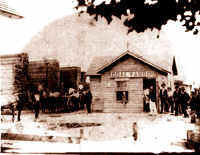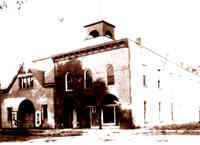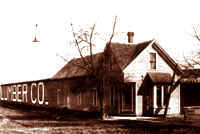|
 |
Farmer City History Cont'd
| In the late 1700's and early 1800's most of central Illinois was rolling prairie with some heavily wooded areas. The solitude of the prairies and of the woodlands which bordered Salt Creek and other streams, was unbroken save by the cry of the wolf or perchance, the call of the Kickapoo or Pottowottomie Indians, who lived in this general area of Illinois before the white man attempted to cast his lot in what has become in the century and more since, a garden spot second in beauty and importance to none in the entire Width and breadth of the United States. The Indians roamed the area, and the white men here were traders or adventurers. |
| After 1825 settlers from states east and south of Illinois started coming into the county. To Dennis Hurley is given the credit of being the first permanent white settler in what is now Santa Anna Township. He came here in the fall of 1830 and built a small cabin in what has since been called Hurlev's Grove. Most localities in central Illinois were named from timber tracts which the early pioneers called groves. Blooming Grove, so called because flowers which grew over the trees in the spring of the year, afterwards became Bloomington. Sayhrook owes its origin to Cheney's Grove. Urbana was so located because of the Big Grove just north of town. Mahomet, at first called Middletown, owes its origin to the timber which grew along the Sangamon and so does Monticello. Funk's Grove in McLean County, as early as 1824 attracted Isaac Funk and his two brothers-in-law and thereby became the early home of the large Funk and Stubblefield families. |

John Weedman Bank & Hotel Late 1800's |
| It was the timber, as well as the Salt Creek, which attracted the first known explorers to this vicinity. As early as the spring of 1830, five hardy pioneers, Tilden Lane, Sr., William Lane, Matthew K. Merlin, Benjamin L. Lisenby, and J. J. McGraw followed Salt Creek and its branches to view the country. They found a family, they recorded, living in an abandonded Indian wigwam on Section 33, south of the present site of Farmer City, presumably near where the well-known Arbogast home was located for many years, now the site of the Farmer City Recreation Area.
John Danner was this first temporary settler in the Farmer City area. Re was living with his family in the old Indian wigwam when the five explorers came through and he entertained them in truly pioneer fashion. The scouts declared they liked the land, game was abundant, and it seemed, as pioneers expressed it, a likely place to cast one's lot. Even in those remote days, this vicinity was a pleasing place to the eye of the white man. But Danner was not satisfied to remain after the other early settlers came in. Like Daniel Boone, who left Kentucky when a few scattering settlements had been made and pushed on farther west, just so did Danner grow restless and made his way westward towards the setting sun, perishing, it is said, in the Rocky Mountain region in 1846 while enroute to California.
Hurley's Grove, just southwest of present day Farmer City, became a central location for several families who followed Hurley into the area. Among these "snowbirds" were the Kirby, McCord, Clearwater, Webb, Huddleston, Weedman, Covey, Cumming, Johnson, Blalach, and Watson families. At that time, Hurley's Grove was a part of another county, but became part of Dewitt County in 1839. |

Coal & Lumber Yard in 1875 |
Dennis Hurley and these other brave pioneers were not the sort to be here today and gone tomorrow. Many of their descendants are still living in Farmer City. Hurley was the father of twelve children, two of whom died in Ohio before the trek to Santa Anna Township was begun. One daughter, Catherine Hurley, (who later married George Swigart), was the first white child born in this township. Known as "Aunt Kate," she, with her husband, "Uncle George" lived for many years just south of town near the present site of the Maple Grove Cemetery. She was born July 16, 1832.
Soon after building his cabin, Dennis Hurley had the misfortune to lose his right hand in a gun explosion. But cutting wood with his left hand and carving out a home for his family with such a handicap as the loss of his right hand meant little to a man of the fortitude and courage of Dennis Hurley. |
| The second family to settle in Hurley's Grove was the Richard Kirby family. Kirby was a brother-in-law to Hurlry. He came here in search of a home, obeying the primitive urge in the breasts of all sturdy Americans a century and a half ago to "Go West". The mighty west was a challenge to hold Americans. And the winning of the west has been one of the most fascinating topics in the annals of our country's history. Richard Kirby lived in the area until his death in 1870.
Nathan Clearwater came in the fall of 1832. He entered the first tract in the township, it being the northeast quarter of the northwest quarter of Section 33, Township 21, Range 5 East. It was entered for record on February 1, 1833. At that time, Bloomington was a tiny settlement, 30 miles distant, and it had only one small store. Truly, the pioneers lived a life which was sufficient unto themselves. This life had to be sufficient, for the pioneers were on their own, and it was a question of survival or failure. They succeeded and Farmer City and DeWitt County today are the fruit of their toil and privations.
From 1833 to 1835 a number of other tracts wee entered, these being by William Y. McCord, Rueben Clearwater, James W. McCord, P. Webb, John Donner, John E. French and E. Covey.
Washington Y. McCord lived a year or two in this area, then pushed toward Clinton. John Weedman, Sr. passed through and settled in McLean County before returning in 1835.
Henry Huddleston came from Indiana and Richard D. Webb, from Kentucky settled here in the early 30's. |
| The early pioneers clung to the timbered belt which followed the meanderings of Salt Creek. They declined to move out on the prairies for many years. They believed they might freeze to death in mid-winter. They were afraid to leave the protection from the cold, frigid winds which the forest primeval afforded them. And there was always plenty of firewood and plenty of game and birds in the trees of the grove. It meant something to Hurley and Clearwater and Webb and McCord to live in the shadows of old Hurley's Grove. One pioneer said he would not pay the taxes on twenty thousand acres of prairie lands if they were given to him free of expense. |

Columbian Opra House left of City Hall building early 1900's |
| Perhaps they were right to seek the shelter of the grove during those early days. On April 9, 1835, a cold and blustery day even in the spring, a man named Ryan was frozen to death in this vicinity. He was a member of a wagon team pushing westward, as the pioneers were wont to do. He became separated from his party by the high waters of the slough at Harris Station, and fell into the icy waters from his ox, stiffened with cold. Richard Webb made a rude casket for the unfortunate man and a short funeral service was held. Thus, the remains of the first man to fall under the lash of death were consigned, as have been many hundreds of others since in this community, to the bosom of Mother Earth. Nathan Clearwater and his wife cared for the family until they could make their way westward across Illinois to their new home near what is now Galesburg.
John and Henry Smith were the first settlers to enter land on the prairie, north of town. They were soon followed by Dan Athey and Sol Smith.
One of the most colorful of the early pioneers was the Reverend Paxton Cumming. Not only was he a devoted preacher of the gospel, but he was also a blacksmith. Indeed a blacksmith who could minister to the mechanical needs of the pioneers was as convenient as a preacher who could minister to the soul needs of the populace on the Lord's Day. Cumming threw his lot in with the pioneer Santa Anna community in the spring of 1835. He was one of God's noblemen. His strength of character, his piety, his meekness, his stalwart faith in the Lord whom he preached, combined with his kit of black-smithing tools made him a valuable asset in the tiny colony nestling in the shadows of Hurley's Grove. He was, unfortunately, not long for this world. He died in September 1839, being the first person buried in what is now Camp Ground Cemetery. His death occurred on the first day of the first camp meeting held in Santa Anna Township. Verily, the camp meetings were not only an all important factor in the religious community, but they also proved to be an opportunity for social gathering. No one can fathom the local historical importance of the general area near the old Camp Ground Cemetery, where meetings were held for those thirsting for righteousness. This area is truly holy ground in the history of Farmer City. |
| From 1835 to 1837 settlers came into Hurley's Grove more rapidly. By 1837 there were 19 families in the grove. The boom was on, and it appeared that the settlements up and down the Salt Creek were to be permanent. Noting the pleasant little mound which arose in Section 29 north westward from Salt Creek, the idea of a pleasant mountain occurred to the hardy pioneers. And thus was the name of Mount Pleasant originated and a new village was born. On January 28, 1837, Squire Hiram Buck of Leroy was called in to survey the plat of Mount Pleasant for Nathan Clearwater, John W. Hadley, and Robert M. Patterson on land owned by Clearwater. He traced the outlines of a new town which from its beautiful location atop the prairie mountain was indeed Mount Pleasant. It may cause us to smile when we, who have seen the towering Rockies, think of our town being on the top of, at least, a prairie mountain. But such it was. |

Alexander Lumber Co. 1910 |
|

